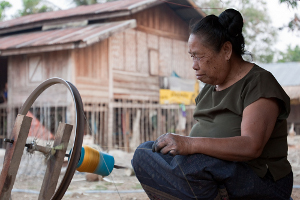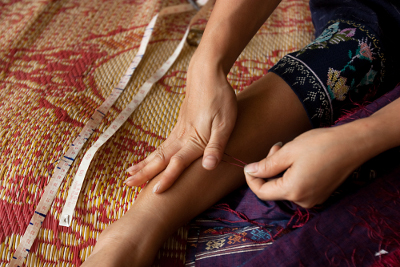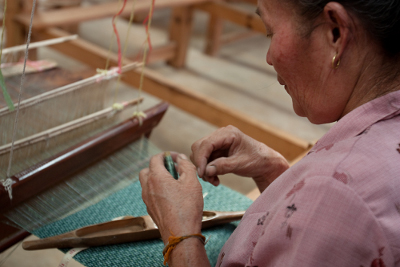
This article has originally been published in the online version of the HandEye magazine, and is republished with permission.
“The voice of a poor man does not carry very far” they say in Laos, and the saying applies perfectly to the situation in which the Laotians find themselves. Their voices, telling tales of difficulties in the face of survival, have not carried very far. The country is landlocked and devoid of spectacular tourist beaches like they have in Thailand, and for many, Laos remains unnoticed on the global map.
As we approach the 2nd decade of the 21st century, rural Laos struggles with an ever weak economy and the legacy of the US bombing of the 1960s and early 1970s, that prompted whole communities to migrate away from their ancestral villages, and in so doing, left behind their extensive knowledge of local natural resources acquired over generations.
In the 1990s, when Laos started to open its borders to visitors as well as trade, it was only a question of time until the country would be brutally exposed to the trials and tribulations of world trade. The reality was that history had left Laotians ill-equipped to participate in the globalized economy. In particular, women in rural Laos didn’t, and often still don’t, have the capital nor the skills to compete in a capitalist system.
Yet – unknown to all but a few, Laos owns something truly rare: a raw diamond in the shape of its textile heritage, and the artisanal and craft skills of its rural population – incidentally the very same people referred to in the rather sad statistics. Laos remains one of the few places in the world where cottage weaving is an important part of everyday subsistence, a necessary and recognized, skilled trade. Interestingly, the cottage industry is predominantly female, with the silk processing skills traditionally handed down from mother to daughter for generations. In this way, the history of Lao women’s home spinning and weaving of silk goes back thousands of years. Even today, weaving is an important part of many rural Laotian women’s daily life.
And it’s precisely the preservation and continued development of the textile heritage of Laos – and Thailand – that is the principle focus of Alleson Kase’s and Ellen Agger’s social enterprise TAMMACHAT Natural Textiles. Alleson had lived in Thailand for most of the 1990s. When she returned with Ellen to Thailand for a holiday, a weaving group they met asked them to buy and re-sell products of theirs – to help their co-op reach new markets. Fast forward. 3 years later, this ‘hobby’ had turned into an independent, full-time business, and Laos was the next logical destination to look for fair trade weaving groups in need of support.

It’s important to note in this context that nearly half the Laotian population is less than 20 years old. Paid work is hard to come by; life expectancy, in comparison to the rest of the world, is low; 1 in 10 children does not get to see its fifth birthday and a whopping 40% of those who do survive suffer from malnutrition; maternal death during or after birth is a fact of life, and a lack of schools and a need for extra farm hands results in a low literacy rate. However, the situation in the country was only one of two key factors in the decision. The other, equally important factor, was that weaving is a part of everyday life in rural Laos, and much of the related skills and knowledge could be lost for good unless successfully marketed outside the region.
Fair trade is TAMMACHAT’s way of doing business as it respects all partners, promotes sustainable practices for the environment and the people involved, and provides a liveable wage for producers. They trade with groups rather than with individuals because groups can promote safety, health, sustainable production practices, skill acquisition, social benefits and community development more easily. When artisans form a group, the group is better equipped to support the collective of individuals in achieving better prices for their products, or in establishing quality standards and control processes. Groups form a social net that if set up well, helps to reduce the risk that stems from the economic, geographic and social differences between artisans and buyers, and the dependence on buyers – effectively middlemen – for access to markets.
The Laotian weaving community has highly developed, skilled and knowledgeable artisans. In many ways, all they need is geographically a more far-reaching market for what they already produce. What is unique about their products is that each individual piece has a story to tell of how it came into being. Everything is hand-made, and whilst no two pieces are completely identical, each piece is a high quality craft product, in rich colours and intriguing patterns. It’s not like something that comes off the rack, with thousands of identical copies. As a consequence, an important part of TAMMACHAT’s work is to recount this background story, and to make a case for the ‘hand-made’ label.
The work of all the groups with whom TAMMACHAT collaborates in Laos as well as in Thailand, rests in essence on the following principles: preservation and cultivation of traditional weaving-related skills and knowledge – specifically on natural dyes – under consideration of a contemporary context; training and education (notably in organic farming or business skills); and community development.

One of the organizations Alleson and Ellen work with is Laos Sericulture Company (LSC), a member of the World Fair Trade Organization. LSC works with close to 500 families based in villages in Northeast Laos, and its aim is to promote and support the people and communities that produce naturally-dyed, handmade Lao silk in a holistic way. For LSC the story of silk starts with the breeding of the cattle that produce the manure which is the basis of the compost that fertilizes the mulberry trees. This approach encompasses things such as dye stuff made from plants and trees, or research into ancient weaving patterns. While old weaving patterns have been preserved in antique fabric samples, the work with natural dyes is a journey of re-engineering and discoveries. Much of the knowledge, tied to the soil and the environment where communities had lived for generations before the bombings, was lost when they migrated. Only now is it being painstakingly rediscovered through much research and experimentation.
Houey Hong Vocational Training Centre for Women is another organisation TAMMACHAT works with. Located at a short distance from Laos’ capital Vientiane, the center employs and trains women from disadvantaged backgrounds from across Laos, and even from Myanmar. The women learn about natural dyeing techniques, traditional Lao weaving, tailoring and also how to run a small business.
In both cases, rather than a lack of skills, it is the lack of access to markets outside of Laos that puts their efforts at risk. By creating a market and a customer base for these goods in North America and beyond, and by paying fair prices, TAMMACHAT contributes to these women’s livelihoods in an area of Laos where subsistence is difficult to achieve. The benefits that derive for the community from this ‘trade, not aid’ approach creates new sources of income, which again puts them in charge of their own destiny. In one specific case, a community LSC works with was, until quite recently, only accessible by foot – a 6 to 8 hour hike, which is precisely how their products found their way to LSC. By now, the village is not only accessible in an hour by 4×4 vehicle, but they also have access to clean water.
In fact, the majority of silk-producing communities in Laos live very remotely. Being self-sufficient is a necessity – which means that every aspect of silk production is taken care of within the community itself. In producing LSC’s textiles, there are up to 21 different individuals – mostly, but not only, women – involved at one stage or another in the making of a single item, and each one of them benefits from its sale!
With the new year approaching, Alleson and Ellen have once again headed for Laos and Thailand in the quest for more interesting products and yet unheard stories to share with the world. I’m curious to see and hear what treasures they unearth.
—
Get to know more about TAMMACHAT Natural Textile on their website at http://www.tammachat.com.

